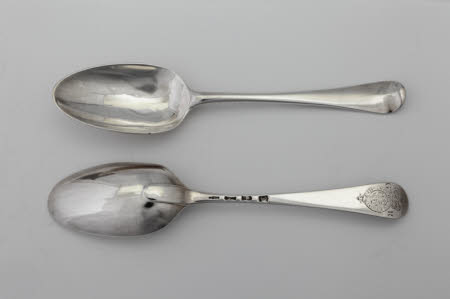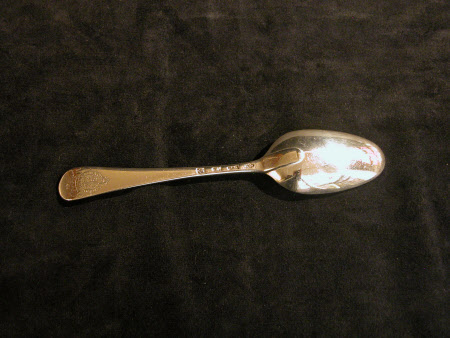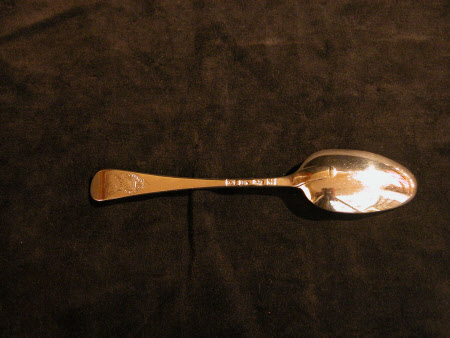Table spoon
probably Thomas and William Chawner
Category
Silver
Date
1766 - 1767
Materials
Sterling silver
Measurements
4.3 cm (Width); 20.3 cm (Length)
Place of origin
London
Order this imageCollection
Ickworth, Suffolk
NT 852099.24
Summary
Table spoon, sterling silver, probably by Thomas and William Chawner, London, 1766/7. One of twenty-nine by various makers and of various dates, eleven of them by the Chawners of this date. The spoon is forged from a single piece of silver. It is of the Hanoverian single-drop pattern with raised egg-shaped bowl, plain, tapering stem and single drop at the junction with the bowl. The terminal is upturned on the bowl side with a slight rib. It is engraved on the reverse of the head of the stem with the royal crest of a lion passant guardant imperially crowned within the Garter and beneath an imperial crown.
Full description
These eleven table spoons were made to match the existing spoons (NT 852099.1-18) and were either an augmentation or a replacement for losses that might have been endured in the rapid exit of the 2nd Earl of Bristol from Spain in 1762 on the termination of his embassy. The marks have been attributed to the Chawners by Arthur Grimwade and are very likely to be theirs but that cannot be proved for certain as the result of the loss of the register for 1758 to 1773. [1] By 1811 there were forty-eight of this pattern of knife and fork remaining, and thirty-six spoons. They had diminished to twenty-four, nine and twenty-seven by 1951. All the surviving forks and spoons and six of the knives came to the National Trust in 1956. [2] James Rothwell, Decorative Arts Curator January 2021 [Adapted from James Rothwell, Silver for Entertaining: The Ickworth Collection, London 2017, cat. 83, p. 172.] Notes: [1] Arthur Grimwade, London Goldsmiths 1697-1837, 1990, pp. 4-5. [2] Suffolk Record Office, HA 507/9/21, List of silver etc offered in lieu of death duties, c.1951, pp. 6 and 16.
Provenance
George Hervey, 2nd Earl of Bristol (1721-75); by descent to the 4th Marquess of Bristol (1863-1951); accepted by the Treasury in lieu of death duties in 1956 and transferred to the National Trust.
Credit line
Ickworth, the Bristol Collection (National Trust)
Marks and inscriptions
Stem: Hallmarks: date letter ‘L’, leopard’s head, lion passant and makers’ marks ‘T∙C’ above ‘W∙C’ (Arthur Grimwade, London Goldsmiths 1697-1837, no. 3816).
Makers and roles
probably Thomas and William Chawner, goldsmith


